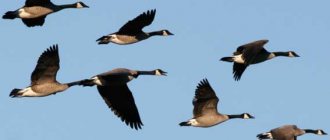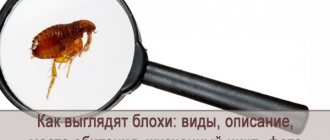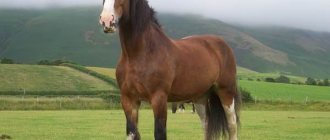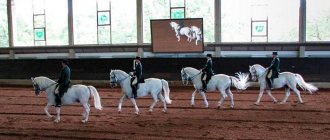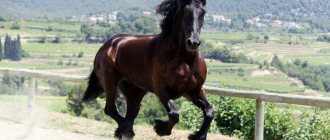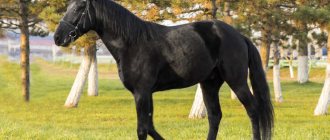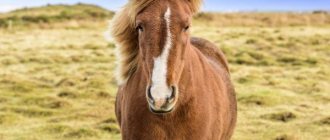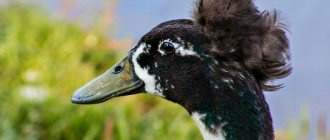Man tamed horses. As a result of selection, many breeds arose. Fur color varies from white to black. Horses' coats come in shades of red, brown and yellow, and a wide range of patterns adorn their bodies. Horses are found piebald and covered with uniform spots. The size of the animal depends on the breed, ranging from 227 to 900 kg in weight, in length from 220 to 280 cm and from 0.9 to 1.7 meters in height.
Description of the horse
The horse has oval-shaped hooves, a long tail, short hair on the body, long slender legs, a muscular and strong body, an elongated strong neck and a large oblong head. The mane is an area of coarse hairs that extends along the dorsal side of the neck in both domestic and wild species. Horses graze on the grass. To chew plants, they have complex and constantly growing molars in their mouths. The thick, winter coat develops in September-October and is fully grown by December. Winter fur begins to shed in spring, and in summer the body is covered with smooth and fine wool.
Other physical features:
- warm-blooded;
- bilateral symmetry of the body;
- both sexes are similar.
Types of horses
Wild horse (Equus ferus), also known as Przewalski's horse
Przewalski's horse
Smaller than most domestic horses. Thick, short neck and short limbs, compact build. The iris of the eyes is usually brown, but some individuals are blue. The mane and tail, unlike domestic horses, shed annually. The mane is dark brown to black and stands straight without a fringe. Domestic horses have long, flowing manes. The tail is short-haired, the hairs gradually lengthen on the sides. Domestic horses have long tail hairs throughout their tail. The muzzle is short and high, light, often white, the edges of the nostrils are dark, the lower edge of the jaw is straight. The skin has two colors: bright yellowish-red-brown and pale gray-yellow. The head and neck are darker than the body. The lower part of the body is lighter than the sides. 3-10 thin dark stripes on legs. A dark dorsal stripe ("eel") runs from the mane down to the tail.
Domesticated horse (Equus ferus caballus)
Domesticated horse
It has a long neck and legs, hard hooves. Over the years of reproduction, people have developed many different hair and coat colors and color patterns. Some of the most common colors are grey, dark reddish brown and light brown. Different breeds vary significantly in size.
Feral horse (Equus caballus)
wild Horse
Morphologically similar to a domestic horse. On average, it is 1-1.6 m high at the shoulder and weighs 350-450 kg. The general appearance varies, with coat colors ranging from black, brown and white to white with orange or brown spots. The coat is short and thin, the tail is relatively short, on the forehead (forelock) and along the neck (mane). The average lifespan of E. caballus is 25 – 30 years.
Kiang (Equus kiang)
Kiang
The kiang's coat is reddish in summer and brown in winter, the lower parts of the body are white, they do not change depending on the season. Kiang is 140 cm shoulder and weighs between 250 and 440 kg.
Kulan (Equus hemionus)
Kulan
Compared to other types of horses, it has short legs. Body color varies depending on the season, reddish-brown in summer, yellowish-brown in winter. They have a black stripe edged with white that runs down the middle of their back. Straight mane of dark color. The belly and chest are white, with characteristic white markings on the back of the shoulder and the front of the rump. On the muzzle there is a white area around the nostrils, the lips are grayish.
Faroe Islands horse (Faroe pony)
Faroese horse
Found in the Faroe Islands in the North Atlantic. This is one of the oldest breeds of horses, very rare, almost extinct.
Mustang
These horses are descendants of a Spanish breed called Iberian horses, technically mustangs are feral horses, not wild horses.
Maintenance and care of horses
A horse, like a pet, requires attention and care. In regions with a warm climate, she can spend almost all her time on pasture. For shelter from bad weather, a shelter under a canopy is enough.
In areas where there are cold winters, horses are kept in stables. The main condition is that it must be dry inside. Drafts are unacceptable, so in the winter all cracks are sealed and the walls are insulated. The stalls are regularly ventilated or equipped with a ventilation system.
The bedding made of hay and straw must be changed as it gets dirty. Drinkers and feeders should be disinfected. It is also important to monitor the horse’s body hygiene. The wool and mane are washed in the warm season by watering with a hose. Pet stores sell shampoos for four-legged friends; it is better to buy them, since regular soap will not work. After bathing, remove moisture from the wool and wipe it with a soft cloth.
The horse's mane is regularly combed using combs. To keep your hair clean longer, you can braid your mane. Hooves need special care. After each walk and hard work, they are inspected, cleaned of dirt and lubricated with special fat.
Terek horse
Caring for a domestic horse also includes veterinary care . It is necessary to monitor the health of the animal and vaccinate regularly. Neglecting vaccinations is dangerous - it can cost your pet’s life.
How to feed?
In summer, the main part of the horse's diet is fresh grass. Cereals are also included in the menu, because they are a source of protein. In winter, the amount of hay is increased, and vegetables are used as vitamin supplements.
Attention! A salt lick is placed next to the pet's feeder. With its help, the animal satisfies the need for minerals.
Feeding is done 2-3 times a day. After eating, the horse can be brought to work 1.5 hours later. Give the animals water in the morning and evening before meals, offering about 30 liters of clean water at room temperature.
Important! Horses often refuse to drink cold water in winter, and this is dangerous to their health. Lack of moisture in the intestines can cause colic and even blockage. During the cold season, the breeder needs to offer the animal warm drinks.
Horse breeds
Horses show a variety of colors and come in different breeds. There are over 350 different breeds of horses and ponies. They are divided into the following groups:
- Light horses with thin bones and legs and weighing less than 590 kg, such as Thoroughbreds, Highbreds, Morgan horses and Arabian horses.
- Heavy or draft horses that weigh more than 600 kg. These are strong breeds with large bones and strong legs, for example Percheron, Brabançon, Russian draft (Bityug).
Modern horse breeds are bred to be both form and function, that is, to have certain physical characteristics needed to perform a particular type of work. Light, refined horses, such as the Arabian or Akhal-Teke, were bred in dry climates for speed and great endurance to travel long distances. A heavy draft horse, such as the Belgian, was sectioned to pull the plow and do other farm work.
Ponies of all breeds are bred by people to please children and to work in places such as mines or where there is not enough food to support large animals.
Between these extremes, horses were bred to perform the following tasks:
- pulled carriages or carriages;
- carried knights in heavy armor;
- participated in horse races;
- performed in circuses;
- used for grazing other animals;
- transported heavy materials.
Horses exhibit four speeds called gaits. They:
- prance slowly;
- trot (slightly faster than prancing);
- light gallop (faster than a trot);
- gallop (the fastest gait of a horse).
Gallop on horseback
Horses with different coat colors have different names. Here are some of the main colors:
- bay – light reddish brown to dark brown with a black mane, tail and shanks;
- red – from apricot to dark chestnut color without black;
- gray - black skin, but a mixed layer of white and black hairs;
- black – completely black;
- brown - a variety of red with reddish fur;
- game - yellowish-brown wool;
- Bulanaya – light golden color;
- piebald is a multi-colored horse with spots of red, brown, white and/or black.
Black horse
Breeding
In order to start breeding domestic horses, you need to have a lot of experience. Thoroughbred specimens should be bred exclusively in accordance with breeding parameters with the permission of the relevant organizations. Before mating, selection or grading is carried out, as well as microchipping and registration for pairs and broods. Males unsuitable for breeding are castrated and must be branded. Stallions that have been castrated are called horses.
Mares are ready for breeding at 3-4 years of age; a stallion is considered sexually mature at 3 years of age. The main condition for successful mating is the female's hunting. The best time for horse mating is from March to June.
There are several ways of mating:
- hand knitting;
- cooking;
- jamb;
- artificial insemination.
When mating by hand, the mare in heat is brought to a special area. Two trained helpers hold her bridle with their own hands. A stallion is brought from behind and will mount the female. He throws out the seed after about 3 minutes, after which mating must be stopped. The stallion is taken to his place, and the mare is walked for half an hour. Control mating is carried out after three days.
During breeding mating, the stallion and mare are locked in an enclosure for several days. Intercourse occurs naturally, but the fertilization rate is lower. The joint method is somewhat similar to the cooking method. A herd or herd of 20-25 females and one breeding stallion is formed. It is kept in a pen or separate pasture throughout the breeding season. The stallion himself chooses mares in heat and mates with them. The method is productive, but it is difficult to plan the characteristics of the offspring.
Artificial insemination of domestic horses is carried out at stations using special instruments. It is used in cases where it is necessary to fertilize a female with the sperm of an elite stallion, and he is located at a great distance. The advantage of the method is that mares are less likely to be injured and sexual diseases are not transmitted to them. The percentage of positive results is high.
A horse's pregnancy lasts 330-350 days; it gives birth to one foal, very rarely - two.
Where do horses live?
The ancestors of horses lived in northern Africa, throughout mainland Europe and Asia. They lived throughout North America during the Late Ice Age, but became extinct approximately 8,000 to 10,000 years ago. Domestic horses currently live alongside humans.
What kind of habitat do horses need?
Horses adapt to different places when domesticated. Preferred habitats are cool, temperate grasslands, steppes and savannas, but animals also live in semi-deserts, swamps and forests.
Warfare
Since ancient times, many breeds of domestic horses have become a real part of life and culture for Asian peoples. On European lands everything was completely different. In many parts of Europe, people did not even know about domesticated horses. This situation continued until the end of the first millennium, when the Greeks began to notice that the Persians, although less trained and disciplined, were regularly defeating them in battle.
It was all about the cavalry - Persian horses at that time were one of the best, and therefore often became a trophy in duels. So European peoples began to use horses more actively, but it would take a lot of time before they began to develop their own breeds.
How do horses reproduce?
Males graze next to females during the mating season, protecting mares from other males who are trying to mate with the females of the herd. Males fight using kicks and hooves.
Pairing
Horses breed during the warm summer months. Pregnancy lasts from 287 to 419 days, which means that birth takes place either in the spring or autumn of the following year. Usually one foal is born; twins are rare.
Childbirth occurs at night and in a quiet place. Foals emerge physically developed. They rise within an hour after birth and stand on their feet after four to five hours, following their mother. During the first month, the cub remains close to its mother. In the second month, he independently obtains food and the process of weaning begins, which takes up to 2 years in wild foals. In domesticated horses, foals are weaned from their mother at 4 to 6 months of age.
Foals walk independently soon after birth, but require assistance. The young rely on their mothers and herd for protection from predators and for food until they can forage on their own. Research shows that wild horses leave the herd they were born into when they are two or three years old.
Thousands of "talking" bones
The “Black Sea” theory was first formulated many years ago by archaeozoologists. They noticed that horse skeletons began to appear en masse in the settlements of ancient people between three and four thousand years ago, and the nature of the remains spoke not in favor of the hypothesis of hunting horses, but rather of their breeding. Wild horses (tarpans) continued to inhabit the same and adjacent territories and remained there for many thousands of years, until the 18th century.
An international collaboration of archaeologists, archaeozoologists and geneticists worked with the support of a Peagasus grant from the European Union. Almost three hundred horse bones were analyzed genetically, DNA was isolated, and clear signs of domestication were identified in them. The homeland of the ancestors of modern domestic horses turned out to be the so-called Pontic steppes - the Black Sea region from the Danube to the Volga. This was assumed by Soviet paleozoologists who studied this region, as well as German specialists collaborating with them.
“This is a very large-scale study, both in terms of geography and time period,” Natalya Abramson, a leading researcher at the Zoological Institute of the Russian Academy of Sciences, told Naked Science. — The result is a fairly plausible picture, the research was carried out at a very high level, but, of course, it cannot answer all the questions. The coverage in paleogenetic analysis cannot, in principle, be high, since the preservation of ancient DNA is low: it looks like a torn book with missing pages. But the genetics of the horse are very well studied, and there is excellent reference data or a genetic map (on which chromosomes which genes are located in this species), which significantly increases the accuracy of the results.”
How long do horses live
Life expectancy depends on several factors, including breed and environment. As a rule, domestic horses live from 25 to 30 years, the maximum record is 61 years. The longest-living horse in nature was registered by zoologists in 1974, its age was 36 years. Factors influencing life expectancy include:
- nutrition;
- what type of activity is the animal used for?
- number of reproduction cycles;
- reproductive status;
- past illnesses;
- dental health;
- physical activity.
Nutritional Features
Horses are herbivores. On a pasture, an adult eats 25-100 kg of grass per day. The average need for drinking water is 30-60 liters in summer and 20-25 liters in winter. Each horse needs about 2 hectares of pasture for adequate nutrition.
Diet
The diet of domestic horses includes oats and hay, but the latter can be replaced by straw. In Italy, Spain, Portugal and in the countries of the East, horses eat barley along with oats.
How herd animals behave
Horses are social mammals. In wild or semi-wild populations, they form herds with a social hierarchy. The herd includes up to 26 mares, 5 stallions and young animals of various ages. Horse herds have a well-functioning social hierarchy, dominated by alpha males. They spend most of their time defending the group from predators and from competing males.
Horses are active at different times of the day, depending on the season. In hot weather, they graze in the morning or evening, avoiding high midday temperatures. Horses sleep segmentally during the day, sleep lasting no more than 2 hours. Animals do not lie on the ground for more than an hour and sleep standing up.
Herd of horses
How do they communicate with each other?
Horses have whiskers on their nostrils and cheeks that are used to sense the environment through touch. Vision is the primary means of obtaining information. The ears are long and straight, which aids auditory perception. Although the sense of smell is important, it is not a primary organ and plays a lesser role than vision or the sensory receptors in the nostrils or cheeks.
Horses communicate with each other through gestures and vocalizations. Members of the herd neigh, bite, push and kick each other to establish or reinforce a hierarchical structure and to express dominance.
Horses have many gestures. Positive reactions include lifting the lips to expose the upper teeth, similar to smiling, tilting the head, or pointing the ears forward and upward. Aggressive facial gestures include ears laid back and teeth exposed with closed nostrils.
Enemies in nature
In the wild, where a horse lives, almost all predators are enemies - lions, tigers, hyenas and others. The attack occurs on the most defenseless - small foals and sick old mares.
The leader enters the battle, driving away the animals. The alpha female leads the wild horses to a secluded area. But if the enemy suddenly managed to drag the victim away, no one will save him. These are the rules.
Sometimes, when the alpha female does not have time to hide her family, wild horses form a ring in which small foals and old mares are hidden. Stallions and young mares do this, and the leader tries to drive away the enemies.
How horses interact with humans
Horses are economically important to people now and historically. They were used as a source of food, transported people and goods, played a role in military campaigns, in sports and recreation, and in the development of agriculture. Horses are beloved pets and are used in therapy and rehabilitation of sick people.
In agriculture, horses harvested crops, plowed fields and vegetable gardens; manure is an important fertilizer. Horsehair is used in a variety of products.
